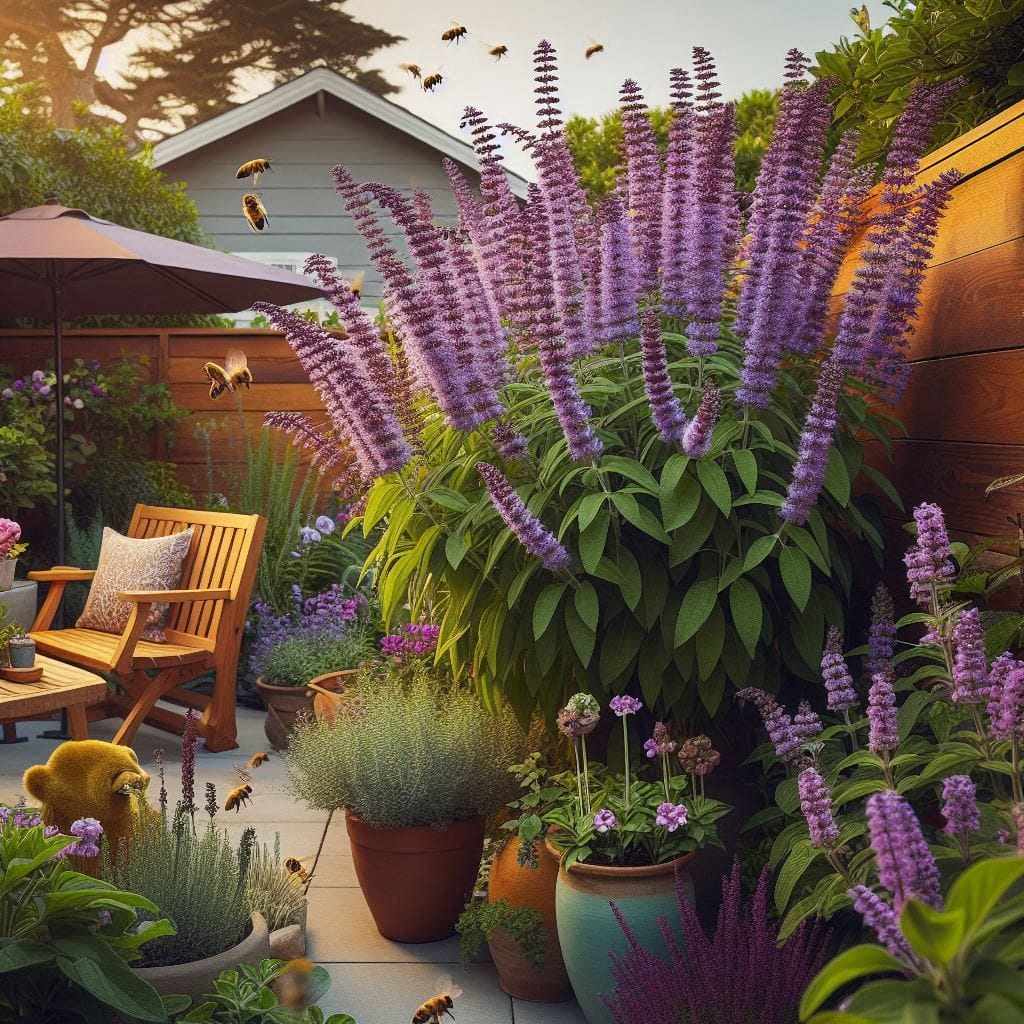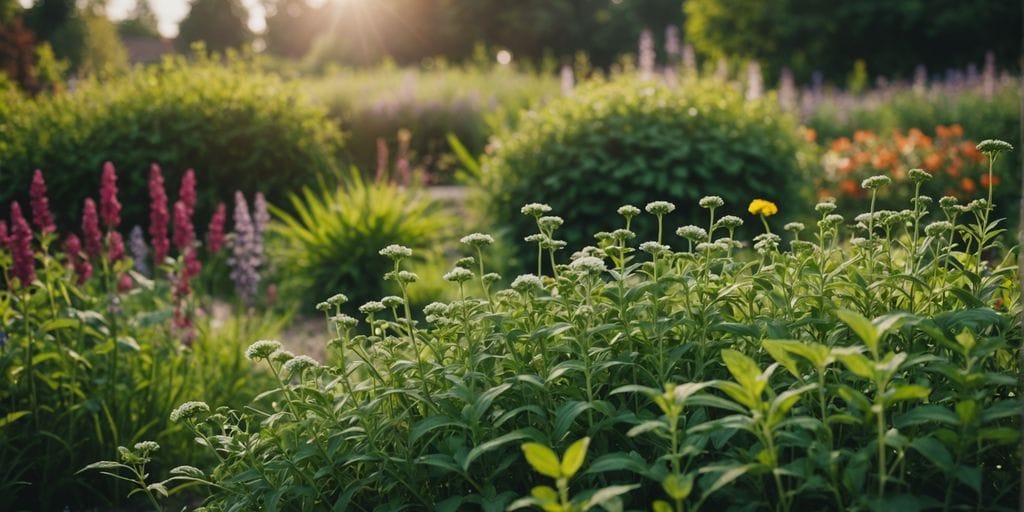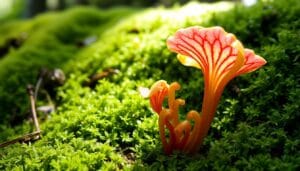Spring is here, and it’s the perfect time to start planting herbs in your backyard garden. Herbs are not only easy to grow but also add flavor and aroma to your dishes. With so many options available, it can be hard to decide which ones to plant. That’s why we’ve put together a list of the top 10 herbs that are perfect for any garden. Whether you’re a beginner or an experienced gardener, these herbs will thrive in your backyard and enhance your cooking.
Table of Contents
Key Takeaways
- Basil is a versatile herb that’s great for cooking and easy to grow.
- Chives add a mild onion flavor to dishes and are perfect for salads.
- Mint is refreshing and can be used in teas, desserts, and more.
- Coriander, also known as cilantro, is essential for many cuisines.
- Dill is great for pickling and adds a unique flavor to dishes.
1. Basil

Basil is a popular herb, especially during the summer months. It’s a key ingredient in many dishes, particularly in Italian cuisine. You can find it in sauces, salads, and more. Basil is best used fresh because it doesn’t hold up well to long cooking times.
How to Grow Basil
- Plant basil in a sunny spot.
- Water it regularly, but don’t let the soil get too soggy.
- Pinch off the flowers to keep the plant producing leaves.
Basil is not just tasty; it’s also packed with vitamins, minerals, and antioxidants. It’s a great addition to any garden.
2. Chives

Chives are a hardy perennial and incredibly easy to grow, making them a fantastic addition to any backyard garden. They belong to the garlic family and are known for their light onion flavor. Chives are native to Asia and have been used in cooking for nearly 5,000 years.
Chives are extremely versatile as the entire plant is edible. The flowers can be used as garnishes, while the bulb and leaves can be added to various dishes. They pair well with eggs, fish, potatoes, salads, shellfish, and soups.
Nutritional Benefits
Chives are not just tasty; they are also packed with nutrients. They are an excellent source of beta carotene and Vitamin C. Additionally, they contain potassium, magnesium, and vitamins A, C, and K.
Growing Tips
- Chives are low-maintenance. Simply plant them in the ground or a pot.
- Place them in a sunny spot for optimal growth.
Chives were once hung in bunches around the house to fend off evil spirits, but today, they are popular border plants thanks to their pretty, purple blossoms.
3. Mint

Mint is a versatile herb known for its refreshing flavor and aroma. It’s perfect for adding a cool touch to summer drinks like mojitos and iced tea. Mint is also great for freshening breath and soothing the stomach.
However, mint is an invasive plant and can quickly take over your garden. To keep it under control, it’s best to grow mint in containers. This way, you can enjoy its benefits without worrying about it spreading too much.
Mint thrives in partial shade and needs plenty of water. It can grow in almost any environment as long as the soil is moist and fertile. Plus, it’s not susceptible to frost damage, making it a hardy choice for any garden.
Mint’s vigorous growth makes it a reliable perennial, coming back year after year to enhance your garden and kitchen.
4. Coriander

Coriander, also known as Chinese parsley, is a versatile herb that is popular in many cuisines around the world. The entire plant is edible, from its leaves to its seeds. The leaves, often referred to as cilantro, have a slightly bitter taste and are commonly used as a garnish in dishes like tacos, guacamole, and curries. The seeds, on the other hand, have a lemony flavor and can be ground into a spice.
- Growing Tips:
- Sow seeds every 2-3 weeks for a continuous harvest.
- Plant in well-drained soil and ensure it gets plenty of sunlight.
- Water regularly but avoid overwatering.
Coriander is not just a culinary delight; it also offers numerous health benefits and is used in herbal remedies worldwide.
Whether you love it or find its taste soapy, coriander is a must-have for any backyard garden.
5. Dill

Dill is a short-lived but hardy annual herb that is easy to grow from seeds. Its aromatic leaves are a favorite in many kitchens. Dill pairs wonderfully with seafood, especially smoked salmon, and is also commonly used with potatoes and in soups.
How to Grow Dill
- Plant dill seeds in well-draining soil.
- It thrives in cooler climates.
- Water a day before harvesting.
- Harvest older leaves first.
Culinary Uses
- Enhances the flavor of fish, lamb, potatoes, and peas.
- Popular in pickling.
Medicinal Benefits
- Aids digestion.
- Helps reduce swelling and cramps.
Dill is not just a culinary delight but also a beneficial addition to your garden, attracting helpful insects like wasps and other predatory insects.
6. Fennel

Fennel is a versatile herb with a mild licorice flavor. All parts of the plant are edible, including the seeds, stalks, bulbs, and fronds. This makes it a great addition to soups, stews, seafood, meats, and salads.
Fennel is native to the Mediterranean but can be grown in many regions. It thrives in sunny spots and dry soil, making it a robust choice for your garden. There are two main types of fennel: one grown for its bulbs and the other for its foliage.
- **Growing Tips: **
- Plant fennel in a sunny location.
- Use well-drained soil.
- Water regularly but avoid overwatering.
Fennel’s aromatic scent and unique flavor can elevate both sweet and savory dishes.
Whether you choose to sauté, grill, or eat it raw, fennel is a flavorful and aromatic addition to any backyard garden.
7. French Tarragon

French tarragon, known scientifically as Artemisia dracunculus, is a favorite among gourmet chefs. Its sweet, anise-like flavor makes it a standout in many dishes. This herb is a key ingredient in classic French recipes like Béarnaise sauce and chicken salad.
How to Grow French Tarragon
Growing French tarragon can be a bit challenging, but it’s worth the effort. Here are some tips to help you succeed:
- Location: Plant in a sunny, well-draining spot.
- Propagation: Best grown from divisions or starts, not seeds.
- Watering: Keep the soil slightly moist but not waterlogged.
- Harvesting: Regularly harvest to promote new growth.
Culinary Uses
French tarragon is incredibly versatile in the kitchen. It pairs wonderfully with chicken, seafood, and eggs. You can also use it to flavor vinegars and oils. For a special touch, add it to soups and sauces.
French tarragon can transform an ordinary dish into something extraordinary with its unique flavor.
Storage Tips
To keep your tarragon fresh, you can freeze or dry the cuttings. This way, you’ll have this delightful herb available year-round.
8. Parsley

Parsley, or Petroselinum crispum, is a versatile herb that is a staple in many gardens. It’s one of the easiest herbs to grow, making it perfect for beginners. This biennial plant is usually grown as an annual in most regions and can be started from seeds or young plants.
Parsley has a mildly bitter taste that enhances the flavor of soups, stews, and salads. It’s also a key ingredient in many Middle Eastern dishes. You can use it fresh as a garnish or mix it into sauces and pestos.
Benefits
- Rich in Vitamin A and C
- Aids in digestion
Growing Tips
- Sow seeds in spring or summer.
- Choose a sunny spot with well-drained soil.
- Water regularly but avoid overwatering.
Parsley is not just a garnish; it’s a hero plant that can elevate the taste of your dishes while providing essential nutrients.
9. Rosemary

Rosemary is a versatile herb known for its fragrant, piney scent. It has a long history of use in both cooking and traditional medicine. This evergreen shrub boasts needle-like leaves that are available year-round, making it a staple in many gardens.
Rosemary is not only functional but also decorative, thanks to its white, pink, purple, and blue flowers. It is often used to add flavor to poultry, meats, and vegetables. The herb holds up well under long cooking times, making it ideal for soups, stews, and roasts.
- **Growing Tips: **
- Prefers dry soil
- Avoid overwatering
- Can be grown indoors during winter in colder zones
Rosemary is a delightful addition to any garden, offering both beauty and utility.
10. Sage

Sage is a versatile herb with an earthy, peppery flavor that can have hints of lemon or mint. Its soft, velvety leaves can withstand long cooking times, making it perfect for hearty dishes like stews and roasts. Sage is also easy to grow and care for, making it a great addition to any backyard garden.
Sage is not only great for cooking but also has several health benefits. It can help with memory issues, relieve cuts, and reduce inflammation. Historically, it was considered a medicinal cure-all.
- Flavor Profile: Earthy, peppery, with hints of lemon or mint
- Uses: Seasoning meats, sauces, vegetables, and winter stews
- Health Benefits: Memory aid, anti-inflammatory, wound healing
Sage’s flavor actually gets stronger as the leaves grow, making it a unique herb in your garden.
Sage is also bee-friendly and can add a splash of color to your garden with its variegated leaves and purple flowers. It thrives in well-drained, sunny areas and can be harvested all year round.
Conclusion
Growing your own herbs in your backyard garden is not only fun but also rewarding. With just a little effort, you can have fresh, flavorful herbs right at your fingertips. Whether you want to spice up your cooking, brew some herbal tea, or simply enjoy the beauty and fragrance of these plants, there’s a herb for every need. So, grab your gardening tools and start planting. Your garden will thank you, and so will your taste buds!
Frequently Asked Questions
What are the best herbs to start with for beginners?
For beginners, basil, chives, and mint are great choices. They are easy to grow and don’t require much maintenance.
How much sunlight do herbs need?
Most herbs need at least 6 hours of sunlight each day. However, some, like mint, can tolerate partial shade.
Can I grow herbs indoors?
Yes, many herbs can be grown indoors as long as they get enough light. A sunny windowsill is usually perfect.
How often should I water my herbs?
Herbs generally prefer well-drained soil. Water them when the top inch of soil feels dry to the touch.
Do herbs need special soil?
Most herbs do well in regular potting soil. Adding some compost can help provide extra nutrients.
How do I harvest herbs without killing the plant?
When harvesting, snip just above a leaf node. This encourages the plant to grow more branches and leaves.





